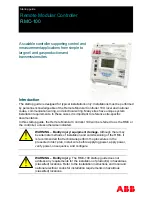
12
| 2105551-001 rev. AC
Table 7 identifies the different module types available that support 9 to 30 V
operation. RMC does not support the TFIO CIM module, part number 2100421.
Table 7: TFIO modules
TFIO module
Part number TFIO software version
Valve Control Combo I/O (M2) 2100412
2100576-007
4–20 mA Analog Output (M2)
2100415
2100715-006
Type II Analog Input (M2)
2100418
2100575-006
Combo Digital (M2)
2100543
2100563-009
Thermocouple (M2)
2100869
2101024-001
RTD (M2)
2101018
2101027-001
CAUTION – Equipment damage.
If using legacy TFIO modules (not
labled as M2), the maximum voltage to operate is 12 Vdc. Applying
more than 12 Vdc will damage the legacy TFIO modules.
Only the TFIO M2 modules support voltages higher than 12 Vdc.
To connect the TFIO module(s):
1. Attach the TFIO module to the DIN rail.
2. Attach the TFIO interface cable to the first TFIO module.
3. Attach the next TFIO module to the DIN rail.
4. Position it beside the previously attached module and snap them together.
5. Repeat steps 3 and 4 to attach the additional TFIO modules as required.
IMPORTANT NOTE:
A maximum of 22 modules is supported by each
port. The TFIO A port does not have to be full before using TFIO B.
6. Attach the 9-pin connector of the TFIO interface cable to the TFIO A port on the
RMC.
7. Using the second TFIO interface cable, repeat steps 1 through 5 for the TFIO B
port.
8. Attach the 9-pin connector of the TFIO interface cable to the TFIO B port.
9. Loosen the terminal connector screws for the correct pin according to Table 8.
10. Insert the wires in the required TFIO pins.
11. Tighten the terminal connector screws.
NOTICE – Property damage.
Do not overtighten the terminal
connector screws as this may damage the wire.



























